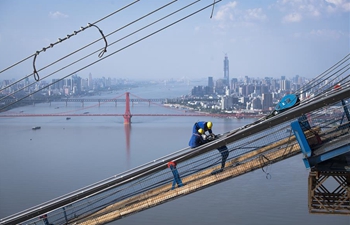BEIJING, July 9 (Xinhua) -- China's air quality has improved across the country, showed a report on the implementation of the Air Pollution Control Law on Monday.
The Air Pollution Control Law and the action plan on air pollution control have been well implemented across the country since the 18th Communist Party of China National Congress in 2012, said the report submitted for review at a session of the National People's Congress (NPC) Standing Committee, which runs from Monday to Tuesday.
The implementation of the law and air pollution control has seen positive achievements, said the report.
The NPC Standing Committee sent four teams to the country's eight provincial-level regions, including Henan, Inner Mongolia and Shanxi, to check the implementation of the Air Pollution Control Law from May to June. They also entrusted local legislatures in 23 other provincial-level areas with law enforcement inspection.
The average density of PM10 in 338 Chinese cities at prefecture level and above in 2017 decreased by 22.7 percent compared to 2013 levels, while the average density of PM2.5 in major areas including the Beijing-Tianjin-Hebei region, the Yangtze River Delta and the Pearl River Delta, fell 39.6 percent, 34.3 percent and 27.7 percent respectively, said the report.
China cut steel production capacity by 170 million tonnes, coal by 800 million tonnes, and cement by 230 million tonnes over the past five years, the report noted.
The proportion of coal consumption dropped 8.1 percentage points while the proportion of clean energy in total energy consumption increased by 6.3 percentage points over the past five years, it said.
According to the report, the main reasons for air pollution in some regions are irrational industrial structure and layout, and unreasonable energy structure and transportation structure.
Traditional industry accounts for 70 percent of the entire industry and the heavy chemical industry makes up 70 percent of the traditional industry in Shandong, it said.
The report said about 78 percent of the country's freight volume were carried by diesel-powered vehicles, which discharged over 60 percent of the country's total vehicle emissions. Shandong is home to over 1.72 million diesel-powered vehicles, accounting for 10.2 percent of the national total and ranking first in China, followed by Hebei Province.
Linfen City in Shanxi Province was found to have fabricated environmental monitoring data from April 2017 to April 2018, it said, adding that major enterprises did not publicize their pollutant discharging information timely, accurately and completely.
The report also raised a number of suggestions to fix the problems, calling for efforts to formulate supporting policies and strengthen supervision on law enforcement.
A regulation on issuance of pollutant discharging licenses should be in place by the end of 2019 to manage stationary pollution sources and coordinate efforts to control multiple pollutants, it suggested.
Environmental protection authorities are asked to put into force a list on toxic and harmful air pollutants by the end of this year, it said.
Local legislatures are encouraged to formulate laws on air pollution control ahead of national legislation and provincial-level people's congresses and their standing committees should make or revise their regulations according to reality, it said.

















